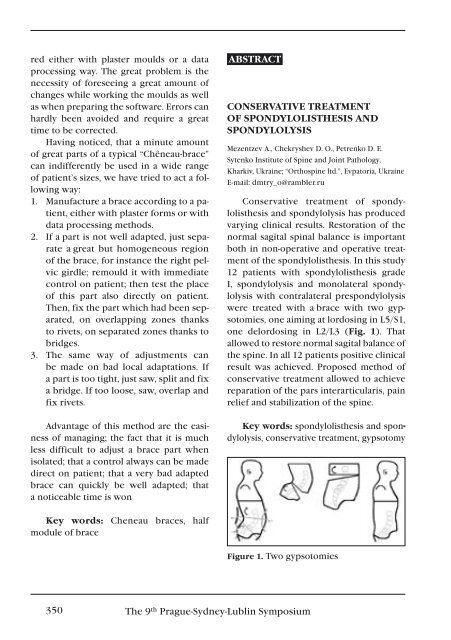Supplementum 3+4/2007 - SpoleÄnost pro pojivové tkánÄ›
Supplementum 3+4/2007 - SpoleÄnost pro pojivové tkánÄ›
Supplementum 3+4/2007 - SpoleÄnost pro pojivové tkánÄ›
Create successful ePaper yourself
Turn your PDF publications into a flip-book with our unique Google optimized e-Paper software.
ed either with plaster moulds or a data<br />
<strong>pro</strong>cessing way. The great <strong>pro</strong>blem is the<br />
necessity of foreseeing a great amount of<br />
changes while working the moulds as well<br />
as when preparing the software. Errors can<br />
hardly been avoided and require a great<br />
time to be corrected.<br />
Having noticed, that a minute amount<br />
of great parts of a typical “Chêneau-brace”<br />
can indifferently be used in a wide range<br />
of patient’s sizes, we have tried to act a following<br />
way:<br />
1. Manufacture a brace according to a patient,<br />
either with plaster forms or with<br />
data <strong>pro</strong>cessing methods.<br />
2. If a part is not well adapted, just separate<br />
a great but homogeneous region<br />
of the brace, for instance the right pelvic<br />
girdle; remould it with immediate<br />
control on patient; then test the place<br />
of this part also directly on patient.<br />
Then, fix the part which had been separated,<br />
on overlapping zones thanks<br />
to rivets, on separated zones thanks to<br />
bridges.<br />
3. The same way of adjustments can<br />
be made on bad local adaptations. If<br />
a part is too tight, just saw, split and fix<br />
a bridge. If too loose, saw, overlap and<br />
fix rivets.<br />
Advantage of this method are the easiness<br />
of managing; the fact that it is much<br />
less difficult to adjust a brace part when<br />
isolated; that a control always can be made<br />
direct on patient; that a very bad adapted<br />
brace can quickly be well adapted; that<br />
a noticeable time is won<br />
ABSTRACT<br />
CONSERVATIVE TREATMENT<br />
OF SPONDYLOLISTHESIS AND<br />
SPONDYLOLYSIS<br />
Mezentzev A., Chekryshev D. O., Petrenko D. E.<br />
Sytenko Institute of Spine and Joint Pathology,<br />
Kharkiv, Ukraine; “Orthospine ltd.”, Evpatoria, Ukraine<br />
E-mail: dmtry_o@rambler.ru<br />
Conservative treatment of spondylolisthesis<br />
and spondylolysis has <strong>pro</strong>duced<br />
varying clinical results. Restoration of the<br />
normal sagital spinal balance is important<br />
both in non-operative and operative treatment<br />
of the spondylolisthesis. In this study<br />
12 patients with spondylolisthesis grade<br />
I, spondylolysis and monolateral spondylolysis<br />
with contralateral prespondylolysis<br />
were treated with a brace with two gypsotomies,<br />
one aiming at lordosing in L5/S1,<br />
one delordosing in L2/L3 (Fig. 1). That<br />
allowed to restore normal sagital balance of<br />
the spine. In all 12 patients positive clinical<br />
result was achieved. Proposed method of<br />
conservative treatment allowed to achieve<br />
reparation of the pars interarticularis, pain<br />
relief and stabilization of the spine.<br />
Key words: spondylolisthesis and spondylolysis,<br />
conservative treatment, gypsotomy<br />
Key words: Cheneau braces, half<br />
module of brace<br />
Figure 1. Two gypsotomies<br />
350 The 9 th Prague-Sydney-Lublin Symposium
















